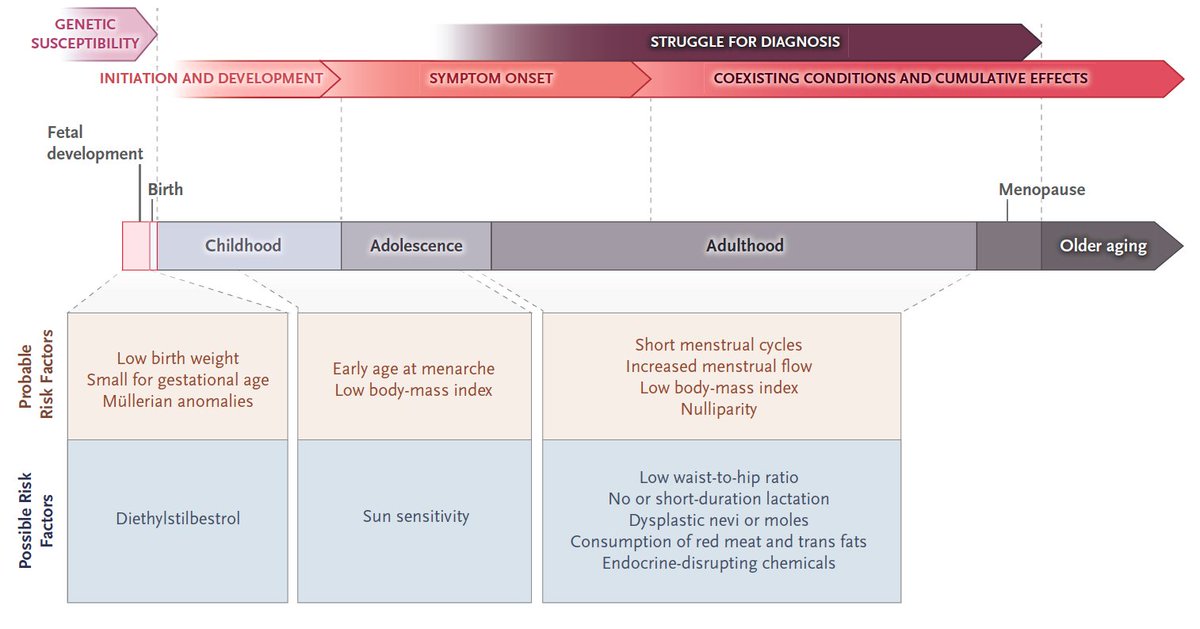Understanding the Complex Nature of Endometriosis
Endometriosis is a disorder that affects 10% of reproductive-age women worldwide. It is characterized by the presence of endometrium-like tissue outside the uterus, and presentations of the disorder range from superficial peritoneal lesions to cysts in the ovaries. Learn more about the complex nature of endometriosis.

NEJM
The New England Journal of Medicine (https://t.co/YGfDrRsIhE) is the world’s leading medical journal and website.

-
Endometriosis is defined as the presence of endometrium-like tissue outside the uterus. However, this definition does not encompass the complex symptomatic, pathobiologic, and multisystemic nature of the disorder. 1/15 pic.twitter.com/qfQGo2qKAb
— NEJM (@NEJM) March 8, 2023 -
Endometriosis is estimated to affect 10% of reproductive-age women, which extrapolates to approximately 190 million women worldwide. However, the true prevalence of endometriosis is uncertain. 2/15
— NEJM (@NEJM) March 8, 2023 -
Presentations of endometriosis range from superficial peritoneal lesions of varying color, to cysts in the ovaries (endometrioma), to nodules with a depth of penetration exceeding 5 mm, to extrapelvic lesions. 3/15 pic.twitter.com/852nqfUBub
— NEJM (@NEJM) March 8, 2023 -
More severe endometriosis, according to the widely used, revised American Society of Reproductive Medicine (rASRM) staging classification (stages I through IV), does not correlate with symptoms, treatment response, or prognosis. 4/15 pic.twitter.com/3CsGnkRzrL
— NEJM (@NEJM) March 8, 2023 -
Although the natural history of endometriosis is unknown, subphenotypes of lesions may vary across the life course. However, no robust evidence supports an ordered progression of endometriotic lesions. 5/15
— NEJM (@NEJM) March 8, 2023 -
The development of endometriosis involves interacting endocrine, immunologic, proinflammatory, and proangiogenic processes. 6/15
— NEJM (@NEJM) March 8, 2023 -
Whether these factors are pathogenic (causal) or merely represent a feature of the pathophysiological process typically measured years after symptom onset remains uncertain. 7/15 pic.twitter.com/ZxQPEkm2O3
— NEJM (@NEJM) March 8, 2023 -
Endometriosis remains difficult to diagnose. No biomarkers to detect or rule out endometriosis are available. 8/15
— NEJM (@NEJM) March 8, 2023 -
The predominantly intraabdominal location of the lesions, plus their small size, means that laparoscopic visualization (ideally with histologic verification) remains the standard for diagnosis of the disease. 9/15 pic.twitter.com/6dM2L8z1Mz
— NEJM (@NEJM) March 8, 2023 -
However, endometriomas can be identified reliably by transvaginal ultrasonography or MRI, with more than 90% sensitivity and specificity. 10/15
— NEJM (@NEJM) March 8, 2023 -
In choosing treatment for endometriosis, it is crucial to consider the patient’s predominant symptoms and preferences, side-effect profile, and age, as well as the extent and location of disease, previous treatment, and costs. 11/15
— NEJM (@NEJM) March 8, 2023 -
Management of endometriosis requires multidisciplinary expertise. Approximately 50% of women with endometriosis have recurrent symptoms over a period of 5 years, irrespective of the treatment approach. 12/15
— NEJM (@NEJM) March 8, 2023 -
Given the high prevalence of endometriosis, the cumulative effect of the disease on health and well-being across the life course, and the high associated economic costs, improvements in awareness, education, and action are long overdue. 13/15
— NEJM (@NEJM) March 8, 2023 -
Progress can be achieved only through sufficiently powered, collaborative, multidisciplinary research, facilitated by funding bodies by means of the prioritization of endometriosis as an important public health issue. 14/15
— NEJM (@NEJM) March 8, 2023 -
To learn more, read “Endometriosis” by Krina T. Zondervan, D.Phil., Christian M. Becker, M.D., and Stacey A. Missmer, Sc.D.: https://t.co/LWdaV2dsLm 15/15
— NEJM (@NEJM) March 8, 2023
